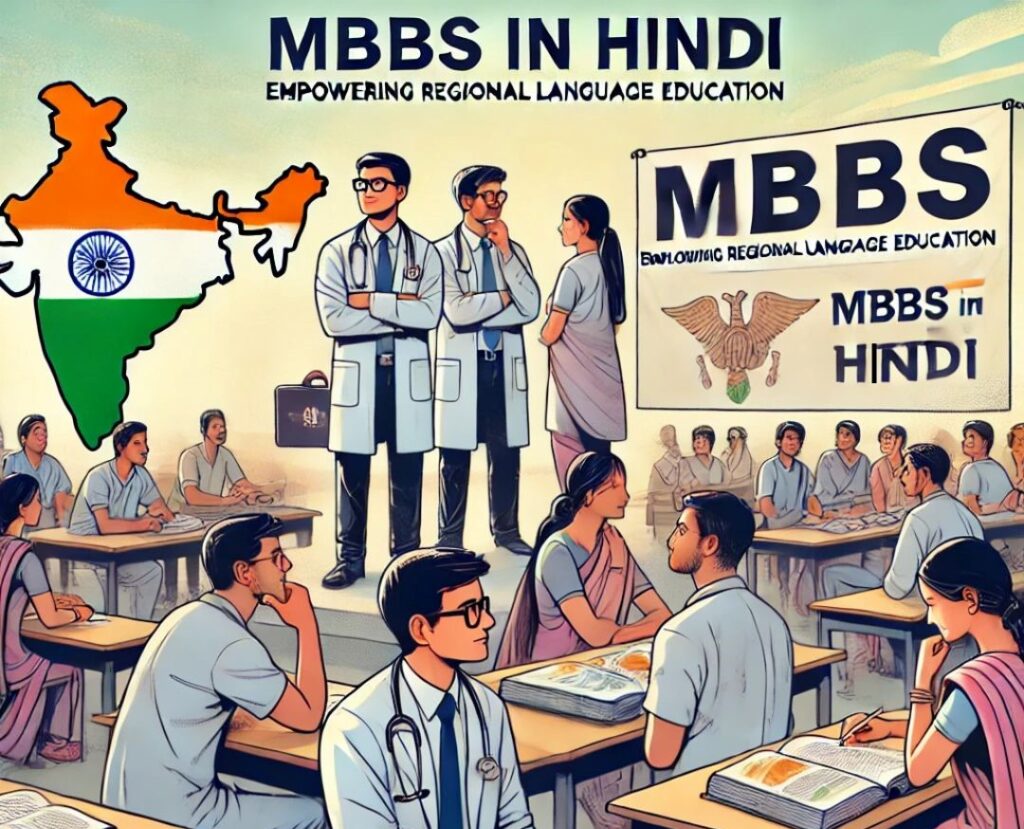India’s diverse linguistic landscape is finding its way into medical education, as several states are now offering MBBS courses in regional languages. In a groundbreaking move, Madhya Pradesh (MP) led the charge by introducing Hindi MBBS courses, and the results have been remarkable—30% of students in the state have opted for Hindi MBBS. Inspired by this success, Rajasthan and Chhattisgarh are following suit, implementing similar programs to make medical education more inclusive and accessible.
This shift toward regional language instruction in medicine is a significant step in addressing long-standing challenges in education, including language barriers and equitable access. In this blog, we will explore the implications of this development, its impact on students and healthcare, and how it aligns with India’s broader educational goals.
The Genesis of Hindi MBBS in Madhya Pradesh
In 2022, Madhya Pradesh became the first Indian state to introduce MBBS courses in Hindi, offering students the opportunity to pursue their medical degrees in their native language. This decision was driven by several factors:
- Overcoming Language Barriers: Many students from rural and semi-urban areas face difficulties learning complex medical concepts in English, which is the traditional medium of instruction.
- Improving Comprehension and Retention: Learning in one’s mother tongue enhances understanding and retention of information, particularly in technical subjects like medicine.
- Encouraging Inclusivity: By introducing Hindi MBBS, the state aimed to make medical education more accessible to students who might otherwise be discouraged from pursuing it due to language constraints.
This pioneering move saw an immediate and positive response, with nearly one-third of enrolled students choosing Hindi as their medium of instruction.
Rajasthan and Chhattisgarh Embrace the Trend
Following the success of Hindi MBBS in Madhya Pradesh, Rajasthan and Chhattisgarh have decided to implement similar programs. These states aim to replicate MP’s model to cater to their large population of Hindi-speaking students. Here’s a closer look at their approach:
- Rajasthan: The state government has announced plans to introduce Hindi MBBS courses in select medical colleges starting in the next academic session.
- Chhattisgarh: Known for its focus on inclusive education, Chhattisgarh has also committed to offering MBBS courses in Hindi to bridge the gap for students from rural backgrounds.
Key Benefits of MBBS in Regional Languages
1. Increased Access to Medical Education
Introducing MBBS courses in Hindi lowers the entry barrier for students from non-English-speaking backgrounds. Many students in rural areas of Madhya Pradesh, Rajasthan, and Chhattisgarh now have the opportunity to pursue medical education without the additional challenge of mastering medical terminology in English.
2. Improved Understanding of Medical Concepts
Medical studies involve complex subjects such as anatomy, pharmacology, and pathology. Studying these in a familiar language enhances comprehension and reduces the cognitive load associated with learning in a second language.
3. Bridging the Urban-Rural Divide
A significant portion of India’s population resides in rural areas, where Hindi is the predominant language. By offering MBBS in Hindi, states can produce doctors who are better equipped to serve in rural healthcare facilities, where language compatibility between doctors and patients is critical.
4. Boosting Confidence and Academic Performance
Learning in one’s mother tongue boosts confidence and can lead to better academic outcomes. Students who might have struggled in an English-medium MBBS course can now perform better in their studies and practical examinations.
5. Promoting Linguistic Diversity in Professional Education
This initiative aligns with India’s rich linguistic heritage, promoting regional languages in professional courses. It sets a precedent for integrating local languages into other fields of study as well.
Challenges in Implementing Hindi MBBS
While the introduction of Hindi MBBS has been met with enthusiasm, it also comes with its set of challenges:
- Translation of Medical Textbooks and Materials: Translating complex medical literature into Hindi is a massive undertaking. Ensuring accuracy and maintaining the integrity of medical knowledge is crucial.
- Training Faculty: Medical educators trained in English must adapt to teaching in Hindi, which requires specialized training and resources.
- Standardization of Terminology: Developing a standardized set of medical terms in Hindi is essential to avoid inconsistencies and confusion.
- Acceptance in the Broader Medical Community: There may be concerns about how Hindi MBBS graduates will be perceived in national and international contexts where English remains the dominant language in medicine.
Impact on Healthcare
The introduction of regional language MBBS courses is likely to have a far-reaching impact on India’s healthcare system:
1. Enhanced Doctor-Patient Communication
Doctors trained in Hindi are more likely to practice in rural and semi-urban areas, where patients predominantly speak Hindi. This improves communication, leading to better diagnosis, treatment, and patient satisfaction.
2. Addressing the Shortage of Rural Doctors
India faces a critical shortage of doctors in rural areas. By offering medical education in Hindi, states can produce more doctors willing and able to work in these regions, improving healthcare accessibility.
3. Strengthening Public Health Initiatives
Doctors familiar with local languages and cultures can play a crucial role in implementing public health programs, raising awareness, and educating communities about preventive healthcare measures.
Future Prospects
The success of Hindi MBBS in Madhya Pradesh and its adoption by Rajasthan and Chhattisgarh could pave the way for other states to follow. There is also potential for:
- Introduction of MBBS in Other Regional Languages: States like Tamil Nadu, Maharashtra, and West Bengal may consider offering MBBS courses in Tamil, Marathi, and Bengali, respectively.
- Expansion to Other Professional Courses: Similar initiatives could be implemented in fields like engineering, law, and management to make higher education more inclusive.
- National Policy Support: The central government could play a role in standardizing and supporting regional language education through funding and policy frameworks.
Conclusion
The decision to offer MBBS in Hindi is a transformative step in India’s education system. With 30% of students in Madhya Pradesh opting for Hindi MBBS, and Rajasthan and Chhattisgarh following suit, the move underscores a commitment to inclusivity and equitable access to professional education. While challenges remain, the benefits—ranging from improved academic outcomes to better healthcare in rural areas—make this initiative a promising model for other states to emulate.
As India marches toward its goal of universal access to quality education, embracing linguistic diversity in medical education is not just a necessity but a reflection of the country’s rich cultural fabric.


